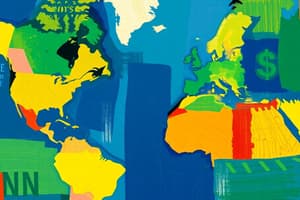Podcast
Questions and Answers
What happens to purchasing power when inflation occurs?
What happens to purchasing power when inflation occurs?
- It remains the same.
- It increases.
- It decreases. (correct)
- It fluctuates unpredictably.
What does a stronger dollar relative to the euro indicate?
What does a stronger dollar relative to the euro indicate?
- The euro is gaining value.
- The euro is depreciating. (correct)
- The dollar is getting weaker.
- The economies are equally strong.
Who primarily influences the nominal exchange rate?
Who primarily influences the nominal exchange rate?
- Market forces. (correct)
- Individual investors.
- Government regulations.
- Central banks.
What does it mean when the exchange rate 'E' is going up?
What does it mean when the exchange rate 'E' is going up?
How does the appreciation of a currency affect purchasing power?
How does the appreciation of a currency affect purchasing power?
What is the primary goal of the Central Bank regarding purchasing power?
What is the primary goal of the Central Bank regarding purchasing power?
What risk preference do most investors exhibit?
What risk preference do most investors exhibit?
In a bilateral exchange rate system, who fixes the value of the Chinese exchange rate?
In a bilateral exchange rate system, who fixes the value of the Chinese exchange rate?
What happens to the price of a currency when demand exceeds supply?
What happens to the price of a currency when demand exceeds supply?
What is the extreme case of a fixed exchange rate?
What is the extreme case of a fixed exchange rate?
What happens to the value of a currency when a country experiences high imports?
What happens to the value of a currency when a country experiences high imports?
What do the liabilities of the Central Bank provide?
What do the liabilities of the Central Bank provide?
How is the monetary basis (MB) defined?
How is the monetary basis (MB) defined?
What does a positive trade balance indicate for foreign reserves?
What does a positive trade balance indicate for foreign reserves?
What is the money supply (M S) formula when cashless money is considered?
What is the money supply (M S) formula when cashless money is considered?
Which of the following is a characteristic of dollarization?
Which of the following is a characteristic of dollarization?
What happens to purchasing power when there is a change in the exchange rate?
What happens to purchasing power when there is a change in the exchange rate?
What does a 20% variation in the exchange rate imply for an investment made in euros?
What does a 20% variation in the exchange rate imply for an investment made in euros?
What is the Nominal Effective Exchange Rate (NEER)?
What is the Nominal Effective Exchange Rate (NEER)?
When calculating the NEER, what type of currencies may be excluded?
When calculating the NEER, what type of currencies may be excluded?
Which partners are considered in the broad NEER calculation?
Which partners are considered in the broad NEER calculation?
What is a consequence of a collapsing exchange rate in emerging countries?
What is a consequence of a collapsing exchange rate in emerging countries?
Why is a bilateral measure preferred by firms over a macro approach?
Why is a bilateral measure preferred by firms over a macro approach?
How might the choice of weights affect the NEER calculation?
How might the choice of weights affect the NEER calculation?
What primarily gives value to paper currency?
What primarily gives value to paper currency?
Which of the following statements about Central Banks is true?
Which of the following statements about Central Banks is true?
How does the historical context of currency differ from current paper currency?
How does the historical context of currency differ from current paper currency?
What is the primary function of a Central Bank regarding currency?
What is the primary function of a Central Bank regarding currency?
What is meant by the phrase 'In God, we trust' on U.S. currency?
What is meant by the phrase 'In God, we trust' on U.S. currency?
Which of the following describes a liability of the Central Bank?
Which of the following describes a liability of the Central Bank?
What is indicated by the phrase 'a currency without physical value'?
What is indicated by the phrase 'a currency without physical value'?
What was a key feature of currencies in earlier economies compared to modern currencies?
What was a key feature of currencies in earlier economies compared to modern currencies?
What indicates the occurrence of a currency crisis?
What indicates the occurrence of a currency crisis?
What is a key feature of floating exchange rate systems?
What is a key feature of floating exchange rate systems?
Which of the following best describes the purpose of an international monetary system?
Which of the following best describes the purpose of an international monetary system?
What was the primary reserve currency during the Gold Standard period?
What was the primary reserve currency during the Gold Standard period?
What is a potential advantage of a fixed exchange rate system?
What is a potential advantage of a fixed exchange rate system?
What happens to the balance of payments in a fixed exchange rate system?
What happens to the balance of payments in a fixed exchange rate system?
Which countries were traditionally part of the G7, that has now expanded to include others?
Which countries were traditionally part of the G7, that has now expanded to include others?
What is the role of liquidity in the international monetary system?
What is the role of liquidity in the international monetary system?
What happens to the money supply when the trade balance increases under a fixed exchange rate?
What happens to the money supply when the trade balance increases under a fixed exchange rate?
How does the Central Bank respond when inflation is too high?
How does the Central Bank respond when inflation is too high?
What does a fixed exchange rate imply about a country's monetary policy?
What does a fixed exchange rate imply about a country's monetary policy?
Under flexible exchange rates, what indicates that a currency will appreciate?
Under flexible exchange rates, what indicates that a currency will appreciate?
What does the Balance of Payments (BoP) equate to under a flexible exchange rate?
What does the Balance of Payments (BoP) equate to under a flexible exchange rate?
In what situation do countries with negative Balance of Payments typically find themselves?
In what situation do countries with negative Balance of Payments typically find themselves?
What is a major characteristic of monetary policy in countries with fixed exchange rates?
What is a major characteristic of monetary policy in countries with fixed exchange rates?
Why do some countries control their monetary policy despite having a surplus in the Balance of Payments?
Why do some countries control their monetary policy despite having a surplus in the Balance of Payments?
Flashcards
Currency Value and Trust
Currency Value and Trust
The value of a currency is not determined by its physical properties but by the trust people have in it.
Banknotes as Liabilities
Banknotes as Liabilities
The creation of banknotes is essentially a liability that the Central Bank assumes, promising that the printed money can be used to purchase goods and services within the economy.
Gold-Backed Coins
Gold-Backed Coins
Historically, coins were backed by gold, meaning their value was directly linked to the weight and value of the gold they contained.
Central Bank and Currency Provision
Central Bank and Currency Provision
Signup and view all the flashcards
Exchange Rate
Exchange Rate
Signup and view all the flashcards
Depreciation
Depreciation
Signup and view all the flashcards
Appreciation
Appreciation
Signup and view all the flashcards
Central Bank's Inflation Objective
Central Bank's Inflation Objective
Signup and view all the flashcards
Inflation
Inflation
Signup and view all the flashcards
Deflation
Deflation
Signup and view all the flashcards
Floating Exchange Rate
Floating Exchange Rate
Signup and view all the flashcards
Fixed Exchange Rate
Fixed Exchange Rate
Signup and view all the flashcards
Flexible Exchange Rate
Flexible Exchange Rate
Signup and view all the flashcards
Currency Union
Currency Union
Signup and view all the flashcards
Dollarization
Dollarization
Signup and view all the flashcards
Currency Board
Currency Board
Signup and view all the flashcards
Central Bank Assets
Central Bank Assets
Signup and view all the flashcards
Central Bank Liabilities
Central Bank Liabilities
Signup and view all the flashcards
Monetary Base
Monetary Base
Signup and view all the flashcards
Exchange Rate Volatility
Exchange Rate Volatility
Signup and view all the flashcards
Nominal Effective Exchange Rate (NEER)
Nominal Effective Exchange Rate (NEER)
Signup and view all the flashcards
Linked Currencies
Linked Currencies
Signup and view all the flashcards
Non-Convertible Currencies
Non-Convertible Currencies
Signup and view all the flashcards
High Inflation Currencies
High Inflation Currencies
Signup and view all the flashcards
How does the Central Bank control the money supply?
How does the Central Bank control the money supply?
Signup and view all the flashcards
Currency Appreciation
Currency Appreciation
Signup and view all the flashcards
Currency Basket
Currency Basket
Signup and view all the flashcards
Import
Import
Signup and view all the flashcards
Export
Export
Signup and view all the flashcards
Loss of Monetary Policy under Fixed Exchange Rate
Loss of Monetary Policy under Fixed Exchange Rate
Signup and view all the flashcards
Balance of Payments (BoP)
Balance of Payments (BoP)
Signup and view all the flashcards
Positive BoP and Reserves
Positive BoP and Reserves
Signup and view all the flashcards
Negative BoP and Reserve Loss
Negative BoP and Reserve Loss
Signup and view all the flashcards
What is an international monetary system?
What is an international monetary system?
Signup and view all the flashcards
What is a floating exchange rate system?
What is a floating exchange rate system?
Signup and view all the flashcards
What is a fixed exchange rate system?
What is a fixed exchange rate system?
Signup and view all the flashcards
How did the gold standard work?
How did the gold standard work?
Signup and view all the flashcards
What is Mint Parity?
What is Mint Parity?
Signup and view all the flashcards
What are fluctuation margins and gold points?
What are fluctuation margins and gold points?
Signup and view all the flashcards
What is a currency crisis?
What is a currency crisis?
Signup and view all the flashcards
Why do investors prefer fixed exchange rates?
Why do investors prefer fixed exchange rates?
Signup and view all the flashcards
Study Notes
Table of Contents
- Exchange Rate and International Monetary Systems (IMS) History
- European Monetary System (EMS)
- Theoretical Relationships
- Models of Monetary Policy and Exchange Rates
- Exchange Rate Misalignment Measurement
- Exchange Rate and the Firm
- Exam
Exchange Rate and International Monetary Systems (IMS) History
- Definition of nominal and effective exchange rates
- Bilateral vs. Multilateral exchange rates
- Exchange rate regimes
- Balance sheets of Central Banks
- Exchange rates and national accounting
- History of the International Monetary System (IMS)
- Aims of international monetary systems
- Historical systems practiced
- Current state-of-the-art
- European Monetary System (EMS)
European Monetary System (EMS)
- EMS history
- EMS-1 and EMS-2 differences
- EMS revival
- Importance of EMS
Theoretical Relationships
- Uncovered interest rate parity
- Purchasing power parity (PPP)
- Dornbusch-Fisher model
- Close economy model (IS-LM)
- Open economy model (Mundell-Fleming)
Models of Monetary Policy and Exchange Rates
- Relation between monetary policy and exchange rates
- Overshooting of the exchange rate
- Exercises related to models
Exchange Rate Misalignment Measurement
- Measures of exchange rate misalignment
- Exchange rate trends
- Deterministic trend
- Moving average
- Hodrick-Prescott Filter
- End-point bias
- Exchange rate misalignments
Exchange Rate and the Firm
- Balance sheet approach
- Mic-Mac link
- Currency risk
- Exchange rate market strategies
- Hedging strategies
- Exercises related to exchange rates and firms
Exam
- Information about the exam format.
Studying That Suits You
Use AI to generate personalized quizzes and flashcards to suit your learning preferences.





